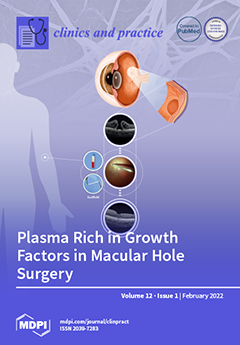Aims: In the present study, we aimed to compare the effect of intravitreal ranibizumab (IVR) treatment on intraocular pressure (IOP) and retinal nerve fiber layer (RNFL) thickness in patients with age-related macular degeneration (AMD) with and without pseudoexfoliation (PEX). Materials and Methods: A
[...] Read more.
Aims: In the present study, we aimed to compare the effect of intravitreal ranibizumab (IVR) treatment on intraocular pressure (IOP) and retinal nerve fiber layer (RNFL) thickness in patients with age-related macular degeneration (AMD) with and without pseudoexfoliation (PEX). Materials and Methods: A total of 24 patients, 12 with PEX (12 eyes) and 12 without PEX (12 eyes), receiving IVR treatment for neovascular AMD between June 2017 and June 2019, were included in the study. Exclusion criteria were composed of the history of glaucoma, uveitis, intravitreal steroid administration, pars plana vitrectomy surgery, and less than three IVR injections. Such criteria as age, gender, follow-up times, number of injections administered, IOP, and RNFL thickness before the first injection and one month after the last injection were also recorded. Results: Age, gender, follow-up time, and the number of injections were similar in groups with and without PEX (
p > 0.05). While mean post-treatment IOP values were not significantly higher in the PEX group (14.50 ± 3.06 vs. 12.91 ± 1.83 mmHg,
p = 0.065), the values were significant for the non-PEX group (13.25 ± 2.76 vs. 11.83 ± 2.69 mmHg,
p = 0.01), and these values were within normal IOP limits. Additionally, RNFL thickness was significantly thinner after treatment in both groups (91.41 ± 7.14 vs. 94.00 ± 6.76 in those with PEX; 95.58 ± 5.91 vs. 97.66 ± 6.89 in those without PEX;
p < 0.05). The decrease in RNFL thickness in the PEX group was 2.58 ± 1.62 µ and in the non-PEX group was 2.08 ± 1.98 µ. However, there was no statistically significant difference between the two groups in terms of RNFL thinning (
p = 0.505). Discussion: Ranibizumab may reduce RNFL thickness in patients with PEX. Longer-term studies including larger populations are necessary for understanding IOP and RNFL changes after anti-vascular endothelial growth factor (anti-VEGF) injection.
Full article






